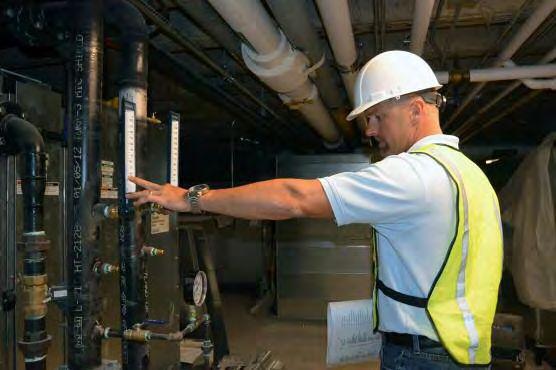
7 minute read
Today’s Workforce
BY KYLIE BLANCHARD
Cooperation between industry and higher education plays an important role in building a strong workforce for the future. Across the region, businesses are experiencing the benefits of working with colleges and universities to develop programs that prepare students with the skill sets to meet their workforce needs.
Developing UAS technologies
The University of North Dakota in Grand Forks; Northland Community & Technical College in Thief River Falls, Minn.; and Northrop Grumman Aerospace Systems, a leading manufacturer of unmanned aerial systems (UAS) technologies based in Redondo Beach, Calif., have recently found success in collaboratively developing UAS training programs and technologies through the schools’ aerospace programs.
“This relationship started to develop in 2009, with preliminary meetings and discussions about how our institutions could work together,” says Dan Klug, chief development officer at Northland. “Northland is one of the premier schools for aerospace maintenance, and UND is one of the premier schools for training pilots. We seemed to complement each other well.”
“The collaboration really covers the full gamut of technologies in the aviation industry,” adds Jonathan Beck, Northland’s UAS program manager. “The aviation industry is changing so quickly, it takes the feedback of industry leaders and other institutions to ensure our programs are meeting the needs of tomorrow’s workforce.”
Klug says the strategic alliance helps to identify opportunities in unmanned aircraft technologies. Currently, Northland is training UAS maintenance crews and data analysts and UND is working towards training UAS pilots and sensor operators.
“Northrop Grumman is currently helping UND to get approval from the State Department for license to train unmanned aircraft pilots, and our institution is working to develop a training system,” says Alan Palmer, director of the UND Unmanned Aerial Systems Center of Excellence.
Palmer says having a relationship with a large company brings many benefits to the schools. “UND and Northland want to be associated with Northrop Grumman because we want to create opportunities for our students. We want to educate and train our students so they can get great jobs within the industry.”
To date, Northrop Grumman has hired three of Northland’s UAS maintenance graduates. “This relationship allows the college to do what it does best, train people and respond to industry needs in the state, nation and internationally,” Klug says. “We truly believe this alliance demonstrates the opportunity for UAS technology to add a strong industry sector to this region.”
Diesel tech program
At the start of 2013, the North Dakota State College of Science in Wahpeton and North Dakota Case IH dealers unveiled a two-year diesel technology program focused on Case IH agricultural equipment and technologies.
“Case IH dealers throughout North Dakota asked NDSCS to develop a customized curriculum that would focus on Case IH equipment and technology,” says Barbara Bang, dean of the NDSCS Technologies & Services Division. “The need for skilled diesel technicians is at a critical point for their companies.”
Bang says Case IH dealers worked with NDSCS faculty and staff for two years to develop the program. “This is a collaborative effort where the dealers provide the resources, including equipment and technology, to be used in the classroom and NDSCS provides instruction, facilities and equipment.”
Each student entering the program is sponsored by a participating Case IH dealer with periodic on-site internships built into the program’s curriculum. When the student graduates, the intent of the program is they will have full-time employment with the dealer.
“The curriculum is designed to include all basic diesel technology theory and extensive hands-on laboratory experience, but much of it is focused on Case IH specific equipment and technology,” Bang says, adding the type of sponsorship provided to each student is determined by the dealer and could include financial assistance, tuition coverage and tools.

“As we continue to provide best-in-class solutions for our customers and suppliers, we must invest in recruiting and educating future technicians throughout our system,” David Meyer, Titan Machinery chairman and CEO, said in a January press release announcing the partnership. “Partnering with NDSCS allows North Dakota Case IH dealers to ensure the ongoing quality of the technicians pipeline in our state.”
Twenty-two freshmen will be accepted into the program for the upcoming fall semester, according to Bang. “This program is our way of responding to strong industry and business requests.”
Developing engineering talent
The relationship between Rapid City’s South Dakota School of Mines & Technology and Caterpillar Inc., a leading manufacturer of construction and mining equipment, diesel and natural gas engines, industrial gas turbines and diesel-electric locomotives, has been ongoing for nearly four decades. However, it was recently expanded through the establishment of the Black Hills Engineering Design Center in the Black Hills Business Development Center located on the SDSM&T campus.
“Six years ago when the Black Hills Business Development Center first opened, a Caterpillar employee and SDSMT alumni felt it would be logical to open the design center in the development center to be close to students and graduates,” says Terri Haverly, executive director of the Black Hills Business Development Center.
Wayne Baumberger, facility manager of the Black Hills Engineering Design Center, says this arrangement has provided Caterpillar with the opportunity to recruit engineering talent from SDSM&T. “The Black Hills Engineering Design Center provides design detailing and engineering services to the business units within Caterpillar. Caterpillar hires individuals to fill design technician and engineering rolls and we typically hire local talent,” he says. “We offer a variety of technical positions that require either associates degrees or engineering degrees, and we also have internships available for these positions.”
The school provides a talent pipeline of students for internships and full-time positions, says Darrell Sawyer, director of the SDSM&T Career
Online
An Emerging Profession
Many professions now require expertise in sustainability. Our Master of Science in Sustainability gives you the edge you need to advance in your career and make a difference to the environment. Graduates of the program are prepared for leadership positions in higher education, industry, utilities, non-profits, and local, state or federal government entities.
Taking the Lead in Going Green

and Professional Development Center. “This partnership provides SDSM&T students and graduates with excellent opportunities in the local area for internships and eventually full-time positions,” he notes. “It also provides opportunities for SDSM&T alumni currently working outside the region to move back to the Black Hills.”
“Caterpillar is a world-class company with a long-standing history,” Haverly says. “When we talk about attracting companies that create the kinds of jobs that will keep our young people here, this is exactly the type of company we mean.”
Students gain experience

The collaboration between South Dakota State University, Brookings, and Brookings Municipalities Utilities has been in place since 1981, providing educational support for the university and filling staffing needs for the BMU wastewater treatment plant.
“It provides a valuable hands-on experience for the students that helps them become better designers and engineers,” says Christopher Schmit, director of the SDSU Water and Environmental Engineering Research Center. “Furthermore, it provides stability for the graduate programs by providing assistantships that allow the program to recruit more students. Lastly, the partnership allows access to the wastewater treatment plant and its staff, and this access is used to help perform research projects.”
The program at the wastewater treatment plant allows SDSU to provide student operators during all night and overnight shifts. SDSU provides operating personnel for 16 hours per weekday and 24 hours on weekends and holidays. The students make rounds at the plant, take readings of the processes and equipment, perform internal testing, respond to alarms and adjust the plant accordingly to make sure it is running properly.
“The program has provided a consistent labor base for operating the facility,” says Paul Melby, BMU utilities operations manager. “The Brookings Utility Board has been very satisfied with the collaboration between SDSU and BMU, and the program and the program directors have met or exceeded all expectations.”
Schmit says researchers are also available to BMU to help solve technical and operational problems at the plant. “These partnerships highlight the significant advantages of working with and having universities available to the public. The universities provide a highly talented pool of individuals that allows these entities to get highly trained and educated individuals to work on problems and, in the case of the BMU, to help operate the plant. The partnerships also allow access to state-of-the-art equipment and technology at the universities that may not be available to the general public.”
Schmit says the collaboration also provides the necessary tools to train the region’s future workforce. “The university relies on these partnerships to bring resources and problems to us so the university can do what it does best and help to solve problems while training new members of the workforce to add to the economic development of the state and region.”
PB
Kylie Blanchard Contributing writer 701-391-0373, kylie.blanchard@hotmail.com
Commissioned buildings lower operating costs increase occupant comfort

BY KELLY HUMBLE
Within the past decade, building commissioning has grown in popularity. It has been proven to save owners money by lowering operating costs and saving time. Commissioning is a quality based process with written documentation of in-depth facility planning, thorough design review, physical inspection of all installed electrical systems. maintenance, fewer change orders, and improved air quality.

The investment in commissioning can result in major cost savings. Industry sources indicate that on average, the operating costs of commissioned buildings range an average of 8% to 20% below that of non-commissioned buildings.
Brent Wavra, a commissioning agent with Commissioning Solutions, says that he has seen projects with very sound design and less than 1% of change orders, but throughout the commissioning process found commissioning reduced change orders by 87% and contractor call backs 90%, thus reducing the total construction costs by an estimated 4% to 9%.*
Bottom line, no matter how carefully a building is designed, if the systems, equipment and materials are not installed and operating as intended, the building will not perform well. Commissioning will help assure that a building is performing the way it was designed to.
When commissioning starts during the design phase of a new con-sioning agent to work with the design team and catch errors on paper, rather than on the job site. Commissioning early will help identify potential problems, therefore reducing change orders and contractor callbacks. This will in-turn help keep the project on schedule and on budget.
Finding a commissioning agent that spends time to go back out and verify each item is crucial to making sure the components are installed corbe individually tracked until there is a satisfactory resolution.
When a more hands-on-approach to commissioning is provided, it the problem. This is an important step to keep the contractor honest and
Keeping all the commissioning responsibilities in-house rather than delegating the time consuming work to the engineers or contractors helps keep relationships and communication strong amongst the team. This insures that the project is successful for everyone involved.
North Dakota State University
Richard H Barry Hall
LOCATION: FARGO, ND
SQUARE FEET: 130,000
YEAR COMPLETED: 2011
TOTAL PROJECT COST: $17 MILLION
TOTAL DEFICIENCIES RESOLVED: 508
Commissioning Solutions











